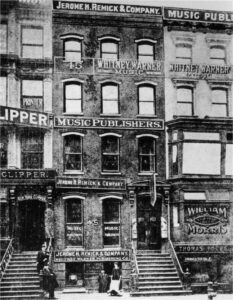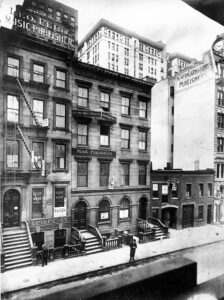 Tin Pan Alley* is the name given to the collection of New York City music publishers and songwriters who dominated the popular music of the United States in the late 19th century and early 20th century.
Tin Pan Alley* is the name given to the collection of New York City music publishers and songwriters who dominated the popular music of the United States in the late 19th century and early 20th century.
The name came from the sound of piano players plugging their songs to music publishers. The “alley” was actually a succession of locations in Manhattan, all more or less along Broadway.
Bear in mind that at this point in time, popular songwriting was, to a large extent, like any other job. People went into an office in one of these buildings and churned out songs. This is not to say that popular songwriting didn’t exist before this. Nineteenth-century composer Stephen Foster managed to write some 200 songs well before the existence of Tin Pan Alley and for all I know, wrote those in his study. (And yet fittingly, Foster, a Pennsylvanian, spent the last four years of his brief life in New York City.)
Nothing was left to chance. Market research was done to determine what was popular and composers wrote to those styles. Testing was done on listeners and performers. Only those deemed to be a hit made the cut. (This reminds me somewhat of Berry Gordy’s quality methods years later at Motown.)
People known as song pluggers were singers and/or piano players who worked in department stores and music stores. “Typically, the pianist sat on the mezzanine level of a store and played whatever music was sent up to him by the clerk of the store selling the sheet music. Patrons could select any title, have it delivered to the song plugger, and get a preview of the tune before buying it.” George Gershwin got his start as a plugger as did Irving Berlin.
There was also a form of song plugging known as booming. The publishers would buy tickets for shows such as cycle races and then would fill many of the seats with their stooges who knew the words to the song they wanted to push.
But in the early days, the major output of Tin Pan Alley composers was not records but sheet music. This is due to the fact that “after the American Civil War, over 25,000 new pianos a year were sold in America and by 1887, over 500,000 youths were studying piano. As a result, the demand for sheet music grew rapidly and more and more publishers began to enter the market.”

The music publishing house Leo Feist on West 28th Street in New York City is seen in this undated photograph. This area is also known as Tin Pan Alley, since numerous famous music publishers set up shop here. (AP Photo)
One promoter recalled a night at Madison Square Garden where “they had 20,000 people there, we had a pianist and a singer with a large horn. We’d sing a song to them thirty times a night. They’d cheer and yell, and we kept pounding away at them. When people walked out, they’d be singing the song. They couldn’t help it.” (Thankfully we’re no longer subject to such aggressive forms of marketing!)
You’re probably getting the idea (correctly) that the music business had – in some instances – quite a bit more to do with commerce than with art. It will probably come as no surprise to you that the guys who became publishers were not songwriters or musicians themselves but had mostly come out of sales. Sales of things like corsets, neckties, buttons and for all I know, magic elixir.
And if you wonder where the practice of publishers putting their own name as co-writer of a song came from, wonder no more. If you were an aspiring, unknown songwriter, as likely as not the “price” of your being published included having one of these publishers put his name on it as well. Either that or sorry kid, no sale. Maybe you can go sell corsets.
By all accounts, Tin Pan Alley was, in its heyday, a lively place. Up and down the street were the sounds of pianos tinkling, song pluggers hearing songs that songwriters were writing in offices and then heading off to “make the rounds of dozens of cafes, music halls, saloons, and theaters nightly, pitching songs, getting them sung by performers, and devising creative methods to get the songs recognized (what we would today refer to as promotion).
Singalongs, free sheet music distribution, staged events (whereby a songwriter pretended to be part of an onstage act) – these were a few of the plugging/marketing techniques initiated in the Alley.”
The date or even exact time period of the demise of Tin Pan Alley is not necessarily agreed upon. Some think it ended during the Great Depression with the advent of phonograph and radio but others say its second heyday was in the Fifties with the advent of rock and roll. Over the years, the location gradually moved from 28th street between 5th Avenue and Broadway up to offices like the Brill Building between 42nd and 50th streets. It’s probably no coincidence that Broadway musical theaters are now mostly located roughly in the latter area. (Via Music Enthusiast)
